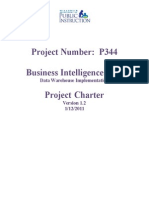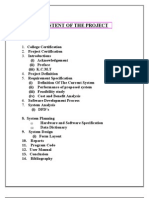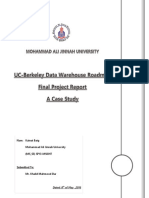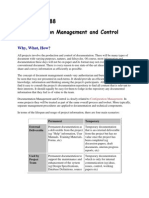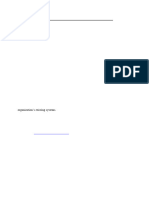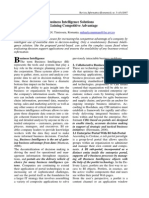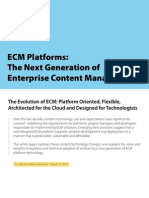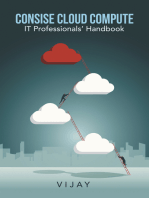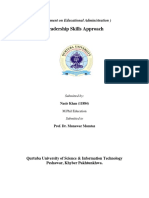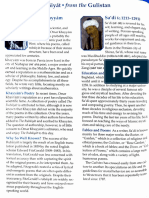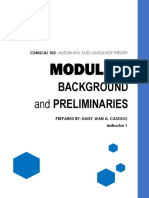Document Management System Workshop: Electronic Records Research 1997: Resource Materials
Document Management System Workshop: Electronic Records Research 1997: Resource Materials
Uploaded by
Avra ChoudhuryCopyright:
Available Formats
Document Management System Workshop: Electronic Records Research 1997: Resource Materials
Document Management System Workshop: Electronic Records Research 1997: Resource Materials
Uploaded by
Avra ChoudhuryOriginal Title
Copyright
Available Formats
Share this document
Did you find this document useful?
Is this content inappropriate?
Copyright:
Available Formats
Document Management System Workshop: Electronic Records Research 1997: Resource Materials
Document Management System Workshop: Electronic Records Research 1997: Resource Materials
Uploaded by
Avra ChoudhuryCopyright:
Available Formats
Electronic Records Research 1997: Resource Materials
Compilation Copyright, Archives & Museum Informatics 1998 The World Bank Group
Document Management System Workshop
by Karl Lawrence
I.
Introduction
A. Classifying Information Management and Access Needs
The World Bank is a knowledge-based organisation whose competitive advantage lies in its vast economic development experience working in numerous countries and across a broad range of sectors over the last 50 years. A key objective of the recently-approved Strategic Compact is to more effectively harness and exploit the knowledge and experience of the Banks staff to deliver more timely and effective products and services to its member governments. As with most knowledge-based organisations the Bank's staff have a variety of knowledge and information management and access needs. These needs fall into the following complementary categories: Knowledge Management: generating new knowledge both through formal research and through learning via networks; capturing information and knowledge through the systematic assembling of existing information; project debriefing; commissioning contributions by Bank experts in subject areas; pulling, reviewing and analysing information from existing internal and external sources; and drawing on discussions from electronic discussion tools and on-line communities. Information Access: access to formal and informal documents and expertise. Workgroup Collaboration: collaborative authoring of documents, electronically-supported discussion, etc. Document Management: creation, assembly, distribution, storage and management of documents.
B.
Knowledge Management
The various Web-based databases and the emergent Knowledge Management System (KMS) seek to address the Knowledge Management, Information Access and Workgroup Collaboration needs of the staff. The KMS is a major pillar of the World Banks institutional renewal programme and addresses longstanding needs of the staff for improved access to internal sources of information and expertise. The KMS seeks to address the requirements for improved information access and means of collaborating with colleagues in- and out-side the organisation. This system is not a monolithic entity. Rather, it is a collection of resources (networks of people, inter-connected systems and processes) designed to capture information at the individual level and disseminate it more broadly to Bank staff, clients and others working in collaboration with the Bank on behalf of its clients. The knowledge resources that are thus accumulated will therefore need to be accessible, irrespective of ones physical locationat headquarters, in field offices, at home, on mission.
C.
Imaging
As part of the evolution from a predominantly paper-based to digitally-based document management system, final-form documents produced or received by units in the Bank are currently scanned, indexed and stored in a document imaging system (IRIS/imageBank) that is being deployed in units across the organisation. This document image store is also being made accessible via Lotus Notes and Web browser, business applications that are commonly available to members of the target audience.
DMS Information Workshop - Background Information
p. 1.
Electronic Records Research 1997: Resource Materials
Compilation Copyright, Archives & Museum Informatics 1998 The World Bank Group
D.
Records/Document Management
In order to support the institutions knowledge and information management objectives, the traditional records management function has expanded its purview to encompass broader document management concerns. Our work implementing the imaging system convinces us that the integrity and utility of this system, indeed any system that aspires to effective management of documents, would be enhanced by capturing the documents during their creation and revision stage. This requires the authoring tools that staff use to create documents to be interfaced with a document management system to enable document content and metadata capture. Capturing the document content and its metadata at creation will enhance life cycle management and ensure the documents availability for reuse.
II.
Purpose of Workshop
A document management architecture has been defined and a document management system, developed internally and referred to as the Document Management Engine (DME), are already in place. Since the DME was developed (it has been tested but not deployed), the Bank announced a new IT strategy that requires use of commercial off-the-shelf software for its business applications. Consistent with this strategy, the purpose of this workshop is to begin a process that will lead to a determination of whether its technically and financially feasible to employ the Documentum software package or the available toolkit to address the Banks records and document management requirements. The time-frame for deciding on the feasibility of employing the Documentum (or alternative software package) solution is the next 6-18 months. The workshop will consider the requirement that the creators of documents in the Bank be able to continue using the common business applications they currently use to produce document content (e.g., MS Word, PowerPoint, Excel). We also want, however, to be able to transparently integrate these front-end document authoring tools with the document management system so that: document content and metadata can be captured at appropriate stages of the document creation and revision stages of the life cycle for storage in the document management system; documents are in easily reusable format (i.e., can be readily repackaged and republished in forms suitable to a variety of audiences); documents are retrievable via common business applications and delivery mechanisms such as Lotus Notes and Web browsers; documents can be preserved independent of a specific hardware/software platform; and the normal records management controls can be efficiently and cost-effectively applied at the back-end of the life cycle process.
III.
Desired Outcomes
Documentum should have a broad understanding of the environment of the Bank and its document management requirements. Bank participants should clearly understand whether and how Documentum could leverage the existing solutionsKMS, Document Management Engine (DME), Lotus Notes, the EFS-based Imaging service and RetrievalWare to provide extended document management functionality (e.g., document checkout/checkin, version control, document-level security, etc.). Specific, concrete next steps for continuing the workshop discussion, to expeditiously resolve open questions such as the product fit (e.g., technical compatibility of Documentum with pieces of the document management solution already in place) and the likely cost to implement, should be agreed.
At the conclusion of this workshop,
IV.
1.
Agenda
Introduction (20 mins.) - Ana Flavia Fonseca: Brief Introduction to the World Bank
DMS Information Workshop - Background Information
p. 2.
Electronic Records Research 1997: Resource Materials
Compilation Copyright, Archives & Museum Informatics 1998 The World Bank Group Information & Technology Services Dept. (ITS) Document Management (DM) Strategy & Work Programme Synopsis of Users Document Management Requirements Document Management & Knowledge Management DM Programme as it Relates to Knowledge Management (10 mins.) - Ana Flavia Fonseca Overview of Knowledge Management System Architecture (15 mins.) - Ramesh Siva Document Management System Document Management Architecture (10 mins.) - Robert Patt-Corner Technical Architecture of the Document Management Engine (DME) (15 mins.) - Robert Patt-Corner Presentation/Discussion - Documentums Document Management Business Solution vs. Bank Requirements (1 hour) Wrap-up: Agreed "Next Steps" (15 mins.)
2.
3.
4. 5.
V.
6. 7. 8. 9. 10. 11. 12.
Issues from April 11, 1996 Teleconference Between ITSIE and Documentum1
The Documentum server can be enhanced, but its basic behaviour cannot be changed. It seems unlikely that Documentum can meet Bank security requirements. There are several possibilities for integrating the Bank security requirements, as currently implemented in the Banks Document Management Engine (DME), with Documentum. Documentum cannot implement the Banks information gathering rules to describe documents (profile attributes), but may be able to store and search the information once it is gathered by the Bank Document Management Engine. Documentum/Notes integration may provide a large group of functions to Bank staff. Much depends on whether the Notes functions that use Documentum are available for modification. The use of Notes as the interface to Documentum instead of Documentums own workspace significantly limits the management functionality provided by Documentum. There is some concern that the current mode of Notes/Documentum integration will require prohibitively large storage in a very large installation like the Bank, due to duplicate storage of large sets of Bank documents. Bank documents must be available to other authorised applications. Documentum manages the location where document content is stored, but appears able to surface enough location information to meet Bank requirements for institutional access to content from outside the Document Management System. The Bank Document Model provides support for multipart, multi-version documents, and Documentum has implemented a different model. Bank search requirements tend to go beyond the standard Documentum/Notes search capability provided by Verity. Scalability issues - current Documentum installations appear somewhat small by Bank requirement standards.
13. 14. 15.
April 1997
1See the 12 April 1996 EM (and attachment) from Robert Patt-Corner to Clem Steyer on Documentum Teleconference. DMS Information Workshop - Background Information p. 3.
Electronic Records Research 1997: Resource Materials
Compilation Copyright, Archives & Museum Informatics 1997 The World Bank Group
VI.
A.
Background Information
What is the World Bank?
The International Bank for Reconstruction and Development, frequently called the "World Bank" was established in July 1944 at the United Nations Monetary and Financial Conference in Bretton Woods, New Hampshire, USA. The World Bank opened for business on June 25, 1946. The World Banks goal is to reduce poverty and improve living standards by promoting sustainable growth and investments in people. The Bank provides loans, technical assistance and policy guidance to help its developing-country members achieve this objective. The World Bank group of institutions includes: The International Bank for Reconstruction and Development (IBRD) The International Development Association (IDA) The International Finance Corporation (IFC) The Multilateral Investment Guarantee Agency (MIGA) The International Centre for the Settlement of Investment Disputes (ICSID) As of February 28, 1997, IBRD and IDA combined employ an active headquarters-based workforce (including regular, fixed-term, long-term consultants and temporary staff) of about 7,259. IFC and MIGA combined employ about 1,105 for a total Bank Group headquarters-based workforce of about 8,364. Local staff in field offices number about 1,676; 71.4 percent of these are support staff. About 434 of the headquarters-based workforce are also assigned full-time to field offices. The Bank has 97 field offices. As of March 15, 1997, IBRD had 180 members; IDA, 159; IFC, 171; MIGA, 141 and ICSID, 126. Bosnia and Herzegovina became the 180th member of IBRD.
B.
Knowledge Management Business Imperative 1. Development Knowledge Management
We need to rebuild our knowledge base and better manage it. Being the global catalyst for the sharing of lessons and expertise on development is potentially our greatest comparative advantageand it is a service greatly needed by our clients. The Networks are the first step in this direction, but we must go further. We need a new culture in which we share experience within the Group, and we need a system which encourages the preservation and exchange of that experience. (Excerpted from January 31, 1997 letter from Mr. James Wolfensohn, World Bank Group President, to Bank Staff)
2.
The VisionWhat is Knowledge Management?
Managing knowledge involves: generating knowledge through research, the networks, the regions and outside sources; systematically assembling this knowledge; and disseminating it both internally and externally through the networks, the regions, EDI, as well as information databases. Initially, it is aimed at increasing individual effectiveness, transferring information and knowledge to the organizational level, and, ultimately, making it easily accessible to all. It constitutes not only a corporate memory of information and best practices, but also incorporates the best development knowledge from outside organizations through connections with universities, foundations, and other world-class sources of knowledge.
Electronic Records Research 1997: Resource Materials
Compilation Copyright, Archives & Museum Informatics 1997 The World Bank Group
3.
How will the knowledge management system be developed?
The (Network) councils will generally take the lead in developing the requisite knowledge bases. Each knowledge area will be led by a full-time knowledge manager and supported by subject-specialists and other operational staff who will spend part of their time building and maintaining the knowledge base. These staff members will constitute communities of practice in their fields of expertise. Other information systems, including those managed by the Regions, OPR, and OED, will also be integrated to form a single institutional system. A small central knowledge management team dedicated to overseeing the knowledge management system will be created. Its functions will include establishing an integrated knowledge management framework, developing an institutional classification system, organizing priorities among multiple knowledge management activities, dealing with issues concerning the quality of knowledge, managing external access to the knowledge management system and consolidating external knowledge partnerships, regulating the Banks knowledge economy, facilitating the organizational culture shift, and championing the Banks knowledge management effort. ITS will support the knowledge management system with the appropriate technology and ensure that the knowledge management system is fully integrated into other information systems.
4.
How will the system be organized?
Material will be organized within the overall framework of the Bankwide architecture (e.g. by sector, region, etc.). Classification procedures will be established to enable easy retrieval and facilitate access to internal and external users. Quality standards will be set. The system will include processes not only to assimilate information, but also to synthesize and distill information into key findings. Feedback mechanisms will be put in place so that the system can evolve to meet changing user requirements. The system will include: help-desks with capacity to answer queries and provide resource maps and information packets; databases including terms of reference, consultants, lessons learned, key articles and books, papers, reports, whats new; knowledge bases including sector strategies, tool kits, model outputs, analytical tools, best practices, sources of information, and think-pieces.
C.
Synopsis of User and Technical Requirements
The key document management requirements on which the existing DME is based are attached.2 Figure 1 depicts the extent to which existing IT solutions satisfy the functional requirements. Significant numbers of the headquarters-based staff involved with country operations work are tend to be on mission (traveling) at any given point in time. Thus access by traveling staff as well as staff located in field offices to the contents of the document management system is of vital importance.
1.
Coverage of Current Solutions
Besides the KMS, Lotus Notes, numerous internal Web databases, other database applications and the Document Management System are used to provide solutions in the document management space diagrammed below. These knowledgebases and repositories all contain documents, whether think pieces especially commissioned by the KMS or the products of normal routine business processes.
2 See also the 12 April 1996 EM and attachment from Robert Patt-Corner to Clem Steyer on Documentum Teleconference. DMS Information Workshop - Background Information p. 5.
Electronic Records Research 1997: Resource Materials
Compilation Copyright, Archives & Museum Informatics 1997 The World Bank Group
D o c u m e n t A u th o r in g
W o rd P ro c e s s o r S p re a d sheet P re s e n ta ti o n
W o r k g r o u p C o m p u tin g E n v iro n m e n t
U s e r In fo r m a ti o n S h a ri n g
C o n te n t M o d e ls
Information Access Services
A p p lic a tio n In te g r a tio n
D o c u m e n t M a n a g e m e n t S y s te m E-Mail
C h e c k - o u t/ C h e c k - i n C o n v e rs io n V e rs io n C o n tro l
Workflow
T e m p la te s
S e a r c h & R e tr ie v a l
C o m p o u n d D o c u m e n ts D o c u m e n t D a ta b a s e ( in c l. M e ta d a ta )
D o c u m e n t / O b je c t I m p o r t - E x p o r t
A p p lic a t io n In t e g r a t io n
Im a g e O b j e c ts Im a g e P ro c e s s in g S y s te m
G ra p h ic O b je c ts D e s ig n & I l l u s tr a t i o n S y s te m
D o c u m e n t O u tp u t
D a ta O b je c ts T e x t O b j e c ts P r i n ti n g V ie w in g
DBM S A p p lic a tio n s
T e x t-b a s e d S y s te m s
L e g e n d : C u r r e n t T e c h . S o l u t io n s L o tu s N o te s In tra n e t D ME R e trie v a lW a re I R I S /i m a g e B a n k
S o u r c e : W o r ld B a n k /G a r t n e r G r o u p
L o tu s N o te s /W e b I R I S /i m a g e B a n k , N o t e s
IR IS , N o te s
Figure 2. Coverage of Functional Requirements by Existing Solutions
D.
Document Management Architecture
Gartner Group advises that in the absence of generalizable Document Management solutions that span applications and work objects, IS must develop its own architecture to grow and protect the information assets of the company. Consistent with this commonsense guidance, the Bank has developed a document management architecture (DMA). The DMA provides a standards-based framework for selecting products and applications, so that documents can be shared and application investments leveraged across applications and architectures. The DMA is based on the following key design, architectural, and technical principles: responsiveness to business needs as expressed through the user requirements; document location independence; adherence to open and de facto industry standards; consistency with IMA and integration with key Bank repositories; open, distributed, client/server computing architecture;
Electronic Records Research 1997: Resource Materials
Compilation Copyright, Archives & Museum Informatics 1997 The World Bank Group object-oriented technology; and scalability and modularity.
DME Architecture
DMS Workstation (Client)
User Interface Lotus Notes, Web, EFS Client Notes,Java Document Capture Service Authoring Tools MS Office Suite
DMS Application Server
Document Access Services Document Database
Oracle
EFS to RetrievalWare
Doc. Indices Search Engine Manual Capture Mail Engine
Library Services Automatic Capture
Engines (robots) to work on mail, PDS, etc. E-mail Workflow ScanStations Lotus Notes
Storage Workflow
EFS, ASCII, PDF
Underlying Infrastructure
Application Integration Integration Standards Network Services Platform Services APIs X.400 TCP/IP OS OLE X.500 Directory Services Unix/POSIX/Windows NT DLLs ANSI SQL Forte CCITT GIV TIFF WWW Servers
NFS
Figure 2
E.
Current Technical Environment 1. Notes Environment
The World Bank is in the process of deploying Lotus Notes. For purposes of the investigation we can assume a Notes client and certificate per desktop and traveling computer. Current release is 4.5.1.
2.
Web Environment
The World Bank has an IP intranet with internet connections and numerous Domino and non-Domino intranet servers as well as non-Domino internet servers. Netscape 3.x is the standard browser, and Notes is configured to use it.
3.
Image Display Environment
The World Bank has a fairly large collection of documents stored as CCITT G4 TIFF images, one image per page, with directories representing logical documents. The images are stored on NFS file systems and can be accessed by both Web and non-Web (e.g. EFS client) viewers. The intention for now is to continue to store images in this manner. Images can be displayed via URL, although there are security issues involved in mapping Notes ACLs to
DMS Information Workshop - Background Information
p. 7.
Electronic Records Research 1997: Resource Materials
Compilation Copyright, Archives & Museum Informatics 1997 The World Bank Group permissions on a Web server offering up the images. This set of issues is to be part of the investigation, either through probing Notes ACLs by the existing Web process or specifying a new Domino process. Images are also displayed in hierarchical Room/Cabinet/Drawer... taxonomy by means of an Excalibur EFS server on UNIX servers and a dedicated EFS client on Windows workstations. This hierarchical display is one key element to be replaced by the product.
4.
Capture Environment
Current image capture is by a dedicated scan station built in house. Maintaining it is resource intensive, but the profiling flexibility is substantial. Additional ad-hoc capture is done by various Bank Web sites and by a Knowledge Management System cataloging system built in Notes which feeds an X.500 database.
5.
Profile and Metadata Environment
The current implementation using EFS works with an ad-hoc set of ORACLE tables to provide some rudimentary picklists and attribute storage on a per file cabinet basis, without normalization or standard design. There is, in addition, a new document management database which captures attribute information in a fully normalized manner and makes use of a full set of metadata, synchronized with common data stores and other Bank processes. The universal capture mechanism relies upon this metadata and database for its operation. The selected document management product must integrate with this data environment, or provide an alternate enterprise means of metadata and profile management.
6.
Search Environment
OCR-produced image text and electronically captured documents are currently searched via the Excalibur EFS search engine, which features a fuzzy bitmap pattern search. Migration is planned to the Excalibur RetrievalWare search engine, offering similar function with the addition of the former Conquest engine.
7.
Security Environment
Current security is implemented by UNIX file protection on the actual images. This is acknowledged to be an unsatisfactory solution. There are two in-house security possibilities. The Notes environment with its certificates offers a rich ACL-based security and a standard user interface for definitions. However it maps poorly to the Web in terms of synchronization with HTTP passwords, and may be inaccessible from other system seeking to validate access. In addition, there is an in-house security engine built in ORACLE PL*SQL which determines security by dynamic ACL, based on document properties, user properties and user membership in organizational hierarchies, and the action requested. However this engine does not have the ubiquitous user interface that the Notes ACL environment provides.
Attachment 1 Page 9 of 3
VII.
User and Technical Requirements
A. Summary of Key Document Authoring Requirements 1.
Identify and reuse related, relevant material
Determine if related documents exist; provide abstract so recipient can determine relevance Create documents from different application components (e.g., Word, PowerPoint, Excel) and formats; convert to users format(s) of choice
2.
Streamline document preparation process
Reduce duration and number of steps Streamline business processes (e.g., number of approval steps) before automating Prompt creator for mandatory profile attributes
3.
Support collaborative work
Edit trace Support preparation and review scheduling Control routing, distribution by end-user or with bankwide directories Provide automatic notification of undeliverable mail Dynamic user control of work group definitions Electronically collate comments from different sources Support collaboration from all locations, including field Support digital signatures Support transfer of document ownership; identify owner of latest version Automatically capture information about who creates/modifies documents
4.
Minimise redundant, non-value-added work
Create and use standard document templates and profiles Perform quality control, consistency checks less often; improve accuracy Automatically generate subsidiary documents from comment content Automatically propagate changes among components for related comments Reduce time spent on document format rather than on substance Provide utilities to compare different versions of the same document
B.
Summary of Key Management Requirements 1. Protect document integrity, prevent loss of documents
Version control of documents and document components Standard file management, locking, protection Document owner can define access privileges, revise on ad hoc basis Document content, associated data stored and retrievable in portable format
2.
Manage document over its life cycle
Capture standard profile information (metadata) on all documents Reuse existing profiles Add profiles to imported (captured) external files Track document The World Bank Group
Attachment 1 Page 10 of 3 Define and maintain rules for retention and disposition Apply retention and disposition rules automatically based on metadata Allow deletion of unused versions Provide support for documents that are stored off-line
3. 4. 5.
Capture borrower and external source documents in digitised, manageable format Provide automated support to assemble documents for publication Manage relationships between/among related documents
Maintain relationship of e-mail to relevant projects or case Track status of responses to borrower correspondence Manage workgroup comments as documents (e.g., editable) Link workgroup comments to the document being referenced Specify versions of document parts to be used to create document editions Maintain profiles (metadata) for all documents, whether in paper or digitised format Maintain profiled of documents stored on non-EDMS servers (e.g., image database)
6. C.
Reduce costs of document storage and retrieval
Summary of Key Document and Information Access & Distribution Requirements 1. Provide on-line access to all Bank information resources, formal and informal
Project documents (including graphics, tables, maps, etc.); bibliography of project files, analysis files, standard model TORs, bidding documents, lessons learned, etc. Banks policies and procedures Research material (e.g., Working Papers, Discussion Papers, etc.) and documents collected on missions Procurement documents Electronic mail Identify Bank experts, consultants
2.
Coordinate and manage information access
Reduce paper by notifying users of document availability and providing access to copy in central database Support simultaneous, read-only access by multiple users Rules to govern user access privileges and authorisations Selective access to document parts Distribute electronic documents in traceable way among document stores and users during their period of active use
The World Bank Group
Attachment 1 Page 11 of 3
3. 4.
Provide access to information regardless of user location Facilitate information sharing
Capture and provide access to borrower documents Share analysis documents with borrowers
5.
Powerful full-text and profile data search and retrieval capabilities
Full complement of search tools Context-based (sector, project, etc.) document retrieval
D.
Summary of Other Requirements 1. Intuitive, easy-to-learn and use user interface
Common to document management and other information services User view of business as context
2. 3. 4.
Gear training to different levels of expertise and needs (e.g., management vs. technical user needs) Integrated, intelligent (i.e., context-sensitive), on-line help and documentation Document management system seamlessly integrated with other information management and access applications (e.g., KMS) System performance
5.
Scaleable to 10,000+ users Usable across heterogeneous enterprise network Quick system initialisation
6. 7.
Support different levels of user technology sophistication Scale solutions and deployment to Banks ability to absorb technology
The World Bank Group
You might also like
- Management Information System KFCDocument27 pagesManagement Information System KFCRitika Yadav83% (54)
- Business Process Management (BPM) Case Study - IBMDocument8 pagesBusiness Process Management (BPM) Case Study - IBMas_ibmNo ratings yet
- Case Study of PWCDocument8 pagesCase Study of PWCnsthegamerNo ratings yet
- The Roadmap ProjectDocument8 pagesThe Roadmap ProjectKainat BaigNo ratings yet
- Bi CharterDocument13 pagesBi CharteramoljajuNo ratings yet
- FOS - Wil's Gril AnalysisDocument7 pagesFOS - Wil's Gril AnalysisDeblina SaharoyNo ratings yet
- Document Management System Workshop: Electronic Records Research 1997: Resource MaterialsDocument11 pagesDocument Management System Workshop: Electronic Records Research 1997: Resource MaterialsercanNo ratings yet
- Library Management System Dhwanit ProjectDocument15 pagesLibrary Management System Dhwanit Projectanonymous3256tNo ratings yet
- Staff AttendanceDocument55 pagesStaff Attendancekituno festo sundayNo ratings yet
- Guideline For Knowledge Management in BPO: ControlledDocument27 pagesGuideline For Knowledge Management in BPO: Controlledchinki_176No ratings yet
- Content of The Project: 1. College Certification 2. Project Certification 3. IntroductionsDocument52 pagesContent of The Project: 1. College Certification 2. Project Certification 3. IntroductionsVickey SaxenaNo ratings yet
- Opentext Enterprise Content Management Ecm Content Server Product OverviewDocument4 pagesOpentext Enterprise Content Management Ecm Content Server Product OverviewUniCluster100% (1)
- Proposal For A Document Management System in The Modern UniversityDocument12 pagesProposal For A Document Management System in The Modern UniversityBHG GlobaltechNo ratings yet
- 11 NFM 11 de 12Document8 pages11 NFM 11 de 12sarthaklko5No ratings yet
- Reading 08 M C 06 ReportingDocument5 pagesReading 08 M C 06 Reportingmarius diaconescuNo ratings yet
- medical shop management systemDocument24 pagesmedical shop management system0007maxsaifNo ratings yet
- The Role of Ict in Knowledge ManagementDocument4 pagesThe Role of Ict in Knowledge ManagementFer LeroyNo ratings yet
- 1.1introduction To Project: 1.2 Objective and Scope of Project ObjectiveDocument11 pages1.1introduction To Project: 1.2 Objective and Scope of Project ObjectiveAbhishek ChavanNo ratings yet
- Submitted By: Nam: Kainat Baig Mohammad Ali Jinnah University (MS - SE) SP13-MS0017Document15 pagesSubmitted By: Nam: Kainat Baig Mohammad Ali Jinnah University (MS - SE) SP13-MS0017Kainat BaigNo ratings yet
- Document Management Techniques and Technologies: December 2003Document10 pagesDocument Management Techniques and Technologies: December 2003Adhiti NayakNo ratings yet
- Teamcenter Document Managementr Emixa - Industry - SolutionsDocument11 pagesTeamcenter Document Managementr Emixa - Industry - SolutionsMirza RahilNo ratings yet
- 0471-4098888 Documentation Management and Control: Why, What, How?Document9 pages0471-4098888 Documentation Management and Control: Why, What, How?Maalini MenonNo ratings yet
- SAAD AssignmentDocument16 pagesSAAD AssignmentThe Dopefein100% (1)
- MCIT Commented GuidlineDocument14 pagesMCIT Commented GuidlineeyobNo ratings yet
- Enterprise Resource PlanningDocument37 pagesEnterprise Resource Planningsharadp007No ratings yet
- Sistem Perencanaan Dan Pengendalian Proyek: Modul PerkuliahanDocument8 pagesSistem Perencanaan Dan Pengendalian Proyek: Modul PerkuliahanLyandaaNo ratings yet
- Ip Project On Sports Shop Management SystemDocument71 pagesIp Project On Sports Shop Management SystemAseer Chandra Lal75% (16)
- English S2Document27 pagesEnglish S2bibezaki1982No ratings yet
- CPX Broch 8.5x11Document4 pagesCPX Broch 8.5x11Vidya Sagar TamminaNo ratings yet
- Business Intelligence Solutions For Gaining Competitive AdvantageDocument4 pagesBusiness Intelligence Solutions For Gaining Competitive AdvantageKurnia Galih PambayunNo ratings yet
- Telephone BillinngDocument89 pagesTelephone Billinnglotim40054No ratings yet
- Sathi A Das 2003Document10 pagesSathi A Das 2003pain2905No ratings yet
- Teamcenter CMS in PLMDocument11 pagesTeamcenter CMS in PLMVenkateshKamepalliNo ratings yet
- The Price Water House CoopersDocument5 pagesThe Price Water House CooperssanchaydodoNo ratings yet
- Core Banking Is A: Banking Bank Branches Bank AccountDocument16 pagesCore Banking Is A: Banking Bank Branches Bank AccountJoseph VelasquezNo ratings yet
- Thesis Electronic Document ManagementDocument8 pagesThesis Electronic Document Managementbsq39zpf100% (2)
- Teamcenter Document ManagerDocument11 pagesTeamcenter Document ManagerManelVazquezNo ratings yet
- Sathi A Das 2003Document10 pagesSathi A Das 2003sami chadharNo ratings yet
- Free and Open Source Document Management SystemsDocument5 pagesFree and Open Source Document Management Systemsade_andika_1No ratings yet
- Part 1 Team Knowlege Base Construction With Mozilla Thunderbird Introduction and Planning.Document6 pagesPart 1 Team Knowlege Base Construction With Mozilla Thunderbird Introduction and Planning.Gary Gabriel100% (2)
- Documentum Ecm Evaluation GuideDocument29 pagesDocumentum Ecm Evaluation GuidealeuzevaxNo ratings yet
- CV - Us EmbassyDocument6 pagesCV - Us EmbassyKevin MbeweNo ratings yet
- II. Project Description: MissionDocument23 pagesII. Project Description: MissionjenNo ratings yet
- Lecture 9Document24 pagesLecture 9prabhathm96No ratings yet
- Data Warehouse Development Management: Facta UniversitatisDocument8 pagesData Warehouse Development Management: Facta UniversitatisSUNGNo ratings yet
- Lotus Notes As KMS Development Tool: As The New Technologies Are Arriving Such AsDocument6 pagesLotus Notes As KMS Development Tool: As The New Technologies Are Arriving Such AsApanshu SinghNo ratings yet
- Business Process Banking-Cognizant PDFDocument7 pagesBusiness Process Banking-Cognizant PDFsupriyoNo ratings yet
- DMS ReportDocument37 pagesDMS Reportsuraj994990No ratings yet
- HotelDocument49 pagesHotelSubham BoraNo ratings yet
- E-Business FundamentalDocument34 pagesE-Business FundamentalPuneet BansalNo ratings yet
- SPRING MEADOWS PUBLIC SCHOOL (AutoRecovered)Document19 pagesSPRING MEADOWS PUBLIC SCHOOL (AutoRecovered)AnkitNo ratings yet
- Enterprise Document Management SystemDocument7 pagesEnterprise Document Management SystemJammy KumarNo ratings yet
- Design and Implementation of An Accounting Database Assistance SystemDocument48 pagesDesign and Implementation of An Accounting Database Assistance Systemncbzkr zkrncbNo ratings yet
- Library Project DocumentationDocument31 pagesLibrary Project DocumentationAnonymous ysOMpRZNo ratings yet
- ECM Platforms - The Next Generation of Enterprise Content Management WhitepaperDocument41 pagesECM Platforms - The Next Generation of Enterprise Content Management WhitepapershahzadaKNo ratings yet
- The Challenges of Global Project Management: Client Case StudyDocument10 pagesThe Challenges of Global Project Management: Client Case StudyNgọc BíchNo ratings yet
- CS PDFDocument24 pagesCS PDFRahul MoreNo ratings yet
- Computerized Asset Management SystemDocument36 pagesComputerized Asset Management SystemLanre Bouncing100% (4)
- Content Management SystemsDocument29 pagesContent Management SystemsLawrence Njoroge100% (1)
- c-projectDocument25 pagesc-projectN KNo ratings yet
- Document and Knowledge Management InterrelationshipsFrom EverandDocument and Knowledge Management InterrelationshipsRating: 4.5 out of 5 stars4.5/5 (2)
- Urban Traffic: Aaditya Garodia Kushal Gupta Manisha Kagra Surabhi KumariDocument72 pagesUrban Traffic: Aaditya Garodia Kushal Gupta Manisha Kagra Surabhi Kumarisurabhi kumariNo ratings yet
- 2023 07 MonitorDocument89 pages2023 07 MonitorMaya KhoNo ratings yet
- (Xavier Institute of Development Action and Studies) : Post Graduate Diploma in ManagementDocument16 pages(Xavier Institute of Development Action and Studies) : Post Graduate Diploma in Managementpriyankverma1No ratings yet
- Leadership Skills Approach: (Assignment On Educational Administration)Document12 pagesLeadership Skills Approach: (Assignment On Educational Administration)Shakeel AhmadNo ratings yet
- Israel Knohl On Hazon GabrielDocument12 pagesIsrael Knohl On Hazon GabrielShalom Hartman Institute100% (1)
- The Rules On Mediation: Legal BasisDocument22 pagesThe Rules On Mediation: Legal BasislambajosepgNo ratings yet
- A Genetic Atlas of Human Admixture History - Garrett Hellenthal Et Al - Science Vol 343 Feb 14, 2014Document6 pagesA Genetic Atlas of Human Admixture History - Garrett Hellenthal Et Al - Science Vol 343 Feb 14, 2014maldoreurNo ratings yet
- Developing An Operations PlanDocument9 pagesDeveloping An Operations PlanleilabubblesNo ratings yet
- Accusative (With Prepositional Compounds, Etc)Document3 pagesAccusative (With Prepositional Compounds, Etc)Barry AndrewNo ratings yet
- Didactic LiteratureDocument11 pagesDidactic Literaturelithium04No ratings yet
- 2W Multi Brand Repair StudioDocument26 pages2W Multi Brand Repair StudioShubham BishtNo ratings yet
- Nursing Resume Template WordDocument7 pagesNursing Resume Template Wordgtbwf3g2100% (1)
- Chapter 3 Ryan DELA CRUZ 12Document13 pagesChapter 3 Ryan DELA CRUZ 12Jen De la CruzNo ratings yet
- Publications de Jan JOOSTEN: Professeur D'ancien TestamentDocument9 pagesPublications de Jan JOOSTEN: Professeur D'ancien TestamentBernand_switzNo ratings yet
- Every Woman Should KnowDocument9 pagesEvery Woman Should KnowAdi ShahrilNo ratings yet
- GPH ScreentimeDocument6 pagesGPH ScreentimeVicta Ryza CatartikaNo ratings yet
- SEBI Guidelines For Buyback For Shares Are As FollowsDocument2 pagesSEBI Guidelines For Buyback For Shares Are As FollowsAtibAhmedNo ratings yet
- CS402 - AL102 Module 1Document4 pagesCS402 - AL102 Module 1Daisy Jean CastilloNo ratings yet
- Ebook of PoemsDocument24 pagesEbook of Poemsapi-519442608No ratings yet
- Tugas B.inggris 1 A Rayhan NDocument2 pagesTugas B.inggris 1 A Rayhan NRahmi DwitaNo ratings yet
- Resume - Harman PDFDocument2 pagesResume - Harman PDFHarman8181No ratings yet
- HACCP Study JoghurtDocument13 pagesHACCP Study JoghurtAliNo ratings yet
- Chapter 5 Making Informed DecisionsDocument22 pagesChapter 5 Making Informed DecisionsRose MangohigNo ratings yet
- How To Size A Control Valve For Liquid and Gas Applications Usi PDFDocument4 pagesHow To Size A Control Valve For Liquid and Gas Applications Usi PDFv noteNo ratings yet
- 2020 Drik Panchang Hindu Festivals v1.0.0Document11 pages2020 Drik Panchang Hindu Festivals v1.0.0maheshNo ratings yet
- Cel2103 Writing Portfolio Task 1 - 30%Document11 pagesCel2103 Writing Portfolio Task 1 - 30%AHMED ALI AHMED / UPM100% (1)
- Marketing Channels: A Strategic Tool of Growing Importance For The Next MillenniumDocument59 pagesMarketing Channels: A Strategic Tool of Growing Importance For The Next MillenniumAnonymous ibmeej9No ratings yet
- Salem Chennai Miss Shobana Mohanasundaram: K.P.N 11WDocument2 pagesSalem Chennai Miss Shobana Mohanasundaram: K.P.N 11WKeerthi KumarNo ratings yet




